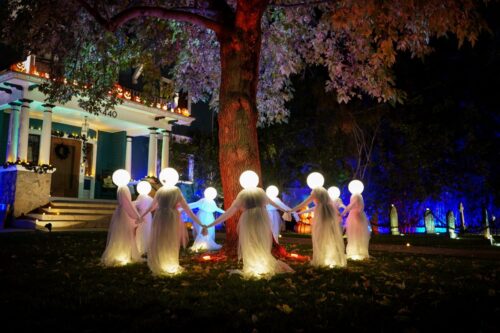Scary Haunted Houses: Love or Hate, It’s Okay Either Way
Halloween is a holiday filled with spooks and scares like scary haunted houses, usually in a fun way. However, a common issue a lot of people with autism have, as well as people in general, is that they experience terror instead of enjoyment.

I have personal experience with the fear of scary haunted houses and the unknown that comes with Halloween in general. When I was a pre-teen, I would feel terror just thinking about the prospect of going in one, even though I knew it was irrational and that I shouldn’t be afraid.
But sometimes your emotions take over and fear is a powerful emotion. When I was a teenager I wanted to push past my fear and go to scary haunted houses, one in particular, which was one of the most famous ones in my home state of Texas. I know that it was kind of like a rite of passage thing, something most “have to do” at that age.
Even though I nearly bailed on going, I’m happy to say I did get past it. And, surprisingly, I had fun! While going to scary haunted houses may not be my thing per se, I don’t feel I would be petrified if I were asked to go into one in the future.
And isn’t that the way fear can sometimes work?
I’m not talking only about scary haunted houses, but doing something that could help you to conquer a fear.
Once you get past the hurdle of whatever it is, knowing that you faced it head-on can be a satisfying feeling. That satisfaction can often fill you with confidence in knowing that you can overcome any challenge.
Never let fear decide your fate as you will always regret it, so within your abilities, I encourage everyone who is neurodiverse to be brave, have courage because it will help you become the best version of yourself, and go for something new and unknown because it can be a lot of fun!
Having said all that, however, I also believe choosing to deliberately experience terror or participate in something you don’t want to do in the name of “fun” should never be forced. That’s where the choice of going to something scary for entertainment comes into play.
Deciding Whether or Not to Go to Scary Haunted Houses
Halloween is just around the corner, and for many people that means visiting scary haunted houses.
These spooky attractions with terrifying scenes, creepy monsters, and shocking surprises have become a staple Halloween tradition.
However, for people with autism like myself, the idea of voluntarily going somewhere chaotic, overstimulating, and designed intentionally to scare you may seem completely irrational.

As someone who falls on the autism spectrum, I have to put extra thought into whether attractions like scary haunted houses are a good idea for me. Things that appeal to the “average” person can be downright traumatic for my nervous system.
When considering paying perfectly good money to go to scary haunted houses, I have to weigh my desire to participate in the festivities of the season with the reality that an attraction geared toward fear may not be the wisest choice for my sensory sensitivities.
Over the years, I’ve developed some strategies that help me evaluate whether or not visiting scary haunted houses is something I can reasonably handle.
Here are my top tips for others on the spectrum to determine if going to scary haunted houses is the right Halloween activity to participate in this year.
Know Your Sensitivities
It’s important to start by reflecting on what types of environments are most challenging for your nervous system.
For me, I know that sudden loud noises easily send me into a panic attack and terror mode. Being touched unexpectedly or having things jump out at me can also be very distressing.
Crowds make me anxious and mental fatigue sets in quickly trying to process so many stimuli at once.
If you react negatively to things like strobe lights, dense crowds, jump scares, fog machines, claustrophobic spaces, disturbing scenes or masks, tight corridors with no escape, and people touching or chasing you, then there’s a good chance scary haunted houses designed specifically to incorporate all those elements could be your worst nightmare.
Being honest with yourself about exactly what sensory inputs you struggle with will help determine if a haunted house is something you can reasonably expect to tolerate or if it’s better to opt for a calmer activity.
Remember, it’s perfectly okay not to go! Many people don’t like scary haunted houses in general.
Ask About Accommodations
While haunted houses are designed to scare people, most operators of them don’t want anyone to be traumatized or jeopardize their safety. For that reason, many scary haunted houses now offer special accommodations to help those who may not enjoy the standard experience.
Calling ahead to ask what types of accommodations the attraction may offer is a great idea. For example, some allow those with sensory issues or anxiety disorders to have a “lights on” walk-through before the house opens where scary elements are minimized.
Others may permit noise-canceling headphones or allow a guest to carry a glow stick that signals monsters to avoid jump scares.
If you explain your situation, most haunted houses will try to work with you to make the experience more enjoyable. Knowing accommodations are available can decide whether or not to go much easier.
Scary Haunted Houses: Start Small
Rather than plunging into extremely scary haunted houses as your first foray into Halloween frights, consider starting with something a bit milder if this is all new to you.
Look for “family friendly” haunted house events during daylight hours or farms that have daytime hayrides and corn mazes with some playfully spooky elements.
Getting your feet wet first with these gentler attractions can help you evaluate your tolerance levels in a safer environment. It also allows you to slowly build up experience with different stimuli at your own pace. Then, if you find you handle the tamer attractions well, you can work up to something more intense.
Have an Exit Strategy Before Entering Scary Haunted Houses

Identify ahead of time which rooms may be problematic for you so you can rush through those quickly.
Having this exit strategy firmly in mind can make the experience less anxiety-provoking. You’ll know exactly what to do if your senses get overloaded. You can even assign a friend to be on “evacuation duty” prepared to swiftly guide you out.
Planning for worst case scenario often means it doesn’t happen. But it is nice to know you can leave the situation quickly if needed.
Bring Support People
Having trusted friends, family members, or support workers accompany you through scary haunted houses can make the experience feel much safer and more manageable. They can act as a buffer in crowded rooms, warn you ahead of time about upcoming scares, block startling elements from your view, and provide calming reassurance if you start to feel panicked.
Surrounding yourself with people who know your needs and sensitivities deeply enhances the haunted house experience. They can act as your eyes, ears, and voice if you become overwhelmed. Let staff members know you need to stay together as a group.
Wear Noise-Cancelling Headphones
Along with having human support, noise-cancelling headphones can be another helpful buffer. They allow you control over one major sensory input—sound. While you’ll still see all the startling visuals, muting the sounds greatly lessens the intensity.
Listen to calming music or a comforting audiobook as you walk through to further separate yourself from the scenarios. You may get puzzled looks wearing headphones, but it’s an autism-friendly adaptation that enables participation.
Ask About Sensory-Friendly Options
In addition to accommodations provided on a case-by-case basis, some haunted houses now designate certain nights as “sensory-friendly.” These events truly transform the whole scary haunted house experience, dialing down intense effects to create a more welcoming environment for those with sensory sensitivities.
Features of a sensory-friendly night may include keeping the lights on low instead of pitch black, lowering the sound effects or eliminating loud sudden noises altogether, minimizing gory images, removing strobe effects, providing fidget tools, having designated quiet areas, training staff on compassionate communication, and more.
Calling ahead to ask if any sensory-friendly evenings are scheduled could make navigating scary haunted houses more manageable for your needs. This shows that some attractions do recognize the need to make Halloween fun for everyone.
Assert Your Needs
Don’t be afraid to clearly state your needs to the staff at a haunted house for any accommodations that would allow you to participate. Most are willing to make adjustments if they’re aware.
For example, ask staff ahead of time if they can refrain from touching or chasing you. Request extra personal space between yourself and groups ahead in line. Ask that spider webs be moved off walkways or masks be removed near you.
The worst they can say is “no” to a request, but asserting your needs often leads to positive outcomes both for that haunted house and for shaping future accessibility. The more we can educate others on making Halloween inclusive for all, the closer we move toward that reality.
Have an Alternate Activity Planned

Listen to your gut instincts about what you can handle. Simply put, not everyone enjoys being scared, and if you are one of them, just don’t go!
Have an alternate activity already planned that you know you’ll enjoy as a fallback. Scary haunted houses certainly aren’t the only way to celebrate.
Go to a costume dance party, pumpkin farm, Halloween parade, or just order pizza and watch your favorite scary movies at home!
Tips for Handling Scary Haunted Houses If You Decide to Go
If after careful consideration you decide to try tackling a haunted house this Halloween, here are some more tips to hopefully make the experience positive and fun rather than stressful:
- Arrive early. Showing up when the attraction first opens means smaller crowds and fresher staff less likely to be desensitized. There will also be more time for any needed accommodations.
- Tell staff upfront about sensitivities. Don’t wait until you’re already having a meltdown. Politely explain from the start what difficulties you have and ask if any assistance is available.
- Request no physical contact. Make sure staff knows not to touch, grab, or restrain you even if that’s their normal practice. Wearing a badge or lanyard that says “No Touch” can help.
- Use a guide rope, if available. Ask for a rope guide through darker maze-like portions to have a tactile path to follow. This prevents disorientation and running into walls or displays.
- Limit startle scares. Request that monsters minimize jump scares directed right at you. Ask if a glow necklace or bracelet can signal your accommodation needs.
- Take sensory breaks. If there are quiet zones within the attraction, make use of them to recharge when feeling overwhelmed before continuing.
- Stim! Flapping, snapping, jumping, deep pressure hugs — use whatever stims help regulate your nervous system. Don’t suppress stims even if you get odd looks. Stimming helps shutter out external stimuli.
- Wear noise-cancelling earbuds. Playing your soothing music, sounds, or audio stories helps control one sensory input, lowering overall overload.
- Verify an exit plan. Confirm where emergency exits are and if there’s a safe word you can use if needing to cut the experience short.
- Bring comfort items. Fidget toys, chewelry (chewable jewelry), soft fabrics, or anything portable that makes you feel secure can provide tangible soothing while amid frightening scenes.
- Request accommodation updates. Providing feedback on how their accommodations are working for you can help the attraction continue modifying their accessibility. Both you and future guests benefit!
With the right planning and support, scary haunted houses can perhaps be an exciting way to celebrate the Halloween spirit. But never ignore warning signs that it’s too much. Prioritizing your health and well-being should always come first. After all, true terror is never fun!
Also, remember that not every haunted house organization may be willing or even able to accommodate your requests.
That’s why checking websites in advance or even asking if special “sensory nights” can be planned is recommended. After all, you never know until you try!
Evaluating if going to a haunted house is right for you requires honest self-reflection, planning, and self-advocacy. With those things in place, you may be able to sufficiently prepare to participate. But skipping the scary haunted house in favor of less intense seasonal activities is also perfectly okay if that’s better for your needs.
Safety, comfort, and enjoyment should always come first for anyone, regardless of whether they are on the spectrum or not.
For more about Halloween activities, read my blog about playing dress up and going trick-or-treating.
While knocking on doors and asking for candy is something typically reserved for younger sets, keep in mind that individuals of all ages, and especially adults, often enjoy playing dress up on occasion. It’s a fun fantasy that lets you be a superhero or warrior, and that is something that most of us never outgrow … regardless of how old we get! Last year, I dressed up as a pretty awesome vampire!
If scary haunted houses aren’t your thing because they give you anxiety, look for costume parties or events that might be more fun for you! It will also give you a chance to role-play as someone else for a short time, and being a superhero, gladiator, or favorite animal is always in style!
Additional Challenges Individuals with Autism Face
Learn more about other issues that autistics face:
- Ways to Tackle Autism Fireworks Anxiety and Sensory Overload
- Autism Family Support: 5 Ways to Achieve A Happy Household
- Behind Closed Doors: Exploring the Dark Side of Autism and Aggression
- New Research Reveals Autism Mental Health Linked to These Disorders
- Surprising Connections: Why Autism and Apraxia Share Common Ground
- Breaking the Silence: Startling Insights about Autism and Depression
- Autism and Holidays: Why Special Occasions Can Be Challenging
- Top 10 Autism Stereotypes That Need to Go Away
- 6 Fascinating Facts About Autism You Probably Didn’t Know
- 8 Popular Ways to Manage and Master Autistic Social Awkwardness
- Autism and Poor Hygiene: The Smelly Truth to Overcome
- Breaking Down Barriers that Challenge Autism and Friendships
- Anxiety and Autism: 5 Powerful Strategies to Conquer Emotions
- Growing Up Autistic: How I Overcame Challenges and Now Thrive